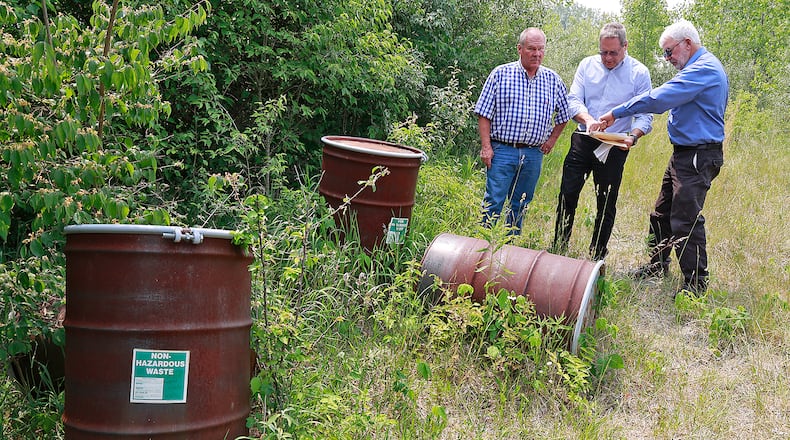The 8.5-acre Tremont City Barrel Fill site in German Twp. — at 3108 Snyder Domer Road — is a closed industrial waste landfill. During operations from 1976 to 1979, it’s estimated about 51,500 drums and 300,000 gallons of industrial liquid waste were disposed of at the site, which threatens the aquifer.
The site contains an estimated 1.5 million gallons of hazardous waste buried in the ground.
Residents have fought for decades to clean up the site.
The disposal stopped in 1980, and soil was later placed on top of the waste cells. Seventeen years later, the U.S. EPA began an investigation into the barrel fill and found some leaks from waste cells. An investigation by the potentially responsible parties in 2005 found most of the waste cells were intact, but showed high levels of contaminants at the barrel fill site.
Contaminants include elevated levels of volatile organic compounds, such as xylenes, ethylbenzene, toluene and methylene chloride. Metals such as chromium and arsenic were also detected in the liquid and solid waste.
Credit: Bill Lackey
Credit: Bill Lackey
In October 2022, the U.S. District Court for the Southern District of Ohio approved a cleanup plan after it granted the motion to approve a consent decree signed in April 2022 by all parties to begin the process of cleaning up the landfill.
The Responsible Environmental Solutions Alliance II (RESA II) is made up of companies ordered responsible for the dumping — Chemical Waste Management Inc., Franklin International Inc., International Paper Co., The Procter & Gamble Co., PPG Industries Inc., Strebor Inc. and Worthington Cylinder Corporation.
In the court order, all responsible companies said they acknowledged they have waste in the landfill and are responsible for the chemicals. They entered into the federal agreement — a Superfund Alternative Approach Agreement — and signed the decree that they will clean it up and shoulder some of the financial burden to do so.
The planned solution: building a new, double-lined cell that is the most protective the EPA can offer and reburying some of the waste while monitoring it forever and shipping some waste off site for proper disposal.
The EPA said the cleanup schedule is on track.
“The groundwater sampling activities at the site are used to determine current groundwater conditions to support the site-wide monitoring plan, which is scheduled to be submitted to EPA in February,” the EPA said.
In October, RESA II submitted a draft preliminary design report for the EPA to review. All parties involved will continue discussions “to review details and concepts in the plan,” and the EPA estimated this review will be complete in the spring, “due to the large amount of information covered and its relevance for the remedial design of the cleanup,” the EPA said.
Larry Ricketts, of citizen advocacy group People for Safe Water, said his organization was encouraged by the test results. He said more detailed tests will be conducted when cleanup moves to the remediation phase in late fall or early next spring.
“After decades of hard work by many people, we are finally at a point where the actions necessary to protect German Twp. residents’ well water and the aquifer which provides Springfield’s drinking water are close at hand,” Ricketts said.
Ricketts thanked U.S. EPA project manager Jenny Polster and RESA II project manager Rob Rule “for their efforts in moving this project forward in a timely manner over the past few years.”
People for Safe Water will continue its partnerships with U.S. EPA, Ohio EPA and RESA II to protect Clark County drinking water, Ricketts said. He said he has requested test results to review before the core stakeholders meet in February.
About the Author


